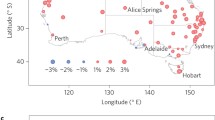Abstract
Throughout the world, flash floods rank as one of the deadliest weather phenomena. In developed countries like the United States, flash floods have claimed more lives over the last 30 years than hurricanes, tornadoes, or winter storms. As this paper was being compiled, flash floods in northern Venezuela claimed at least 15,000 lives on the night of 15-16 December 1999.
Access this chapter
Tax calculation will be finalised at checkout
Purchases are for personal use only
Preview
Unable to display preview. Download preview PDF.
Similar content being viewed by others
References
Alonso, R.R. (1998) Estudio Meteorologico de la situacion del 7 de Agosto de 1996 (Biescas).Serie Monograflas Ministerio de Medio AmbienteCentro de Publicaciones, Secretaria General Tecnica, Spain, 90 pp.
American Meteorological Society (AMS) (1990)Radar in Meteorology: Battan Memorial and 4 0 th Anniversary Radar Meteorology Conference,David Atlas (ed.), AMS, Boston, MA, 806 pp.
Baeck, M.L. and Smith, J.A. (1998) Rainfall estimation by the WSR-88D for heavy rainfall events.Weather and Forecasting13, 416–436.
Davis, R.S. (1997) The integration of the Areal Mean Basin Estimated Rainfall (AMBER) flash flood warning system with automated rain gage data.Preprints 1 st Symposium on Integrated Observing Systems, American Meteorological Society, 189–196.
Davis, R.S. (2000) Detecting flash floods on small urban watersheds.Preprints, 15th Conference on HydrologyAmerican Meteorological Society, 233–236.
Doesken, N.J. and McKee, T.B. (1998) An analysis of rainfall for the July 28, 1997 tlood in Fort Collins, Colorado.Climatology Report 98–1Colorado State University, Fort Collins, CO, 55 pp.
Kelsch, M. (1996) Severe weather information for emergency management decisionmaking.Preprints 1 8 th Conference on Severe Local Storms, American Meteorological Society, 597–601.
Kelsch, M. (1998) The Fort Collins flash flood: exceptional rainfall and urban runoff.Preprints 19 th Conference on Severe Local Storms, American Meteorological Society, 404–407.
Maddox, R.A., Hoxit, L.R., Chappel, C.F, and Caracena, F. (1978) Comparison of the meteorological aspects of the Big Thompson and Rapid City flash floods.Monthly Weather Review106, 375–389.
Maddox, R.A., Chappel, C.F., and Hoxit, L.R. (1979) Synoptic and meso-alpha scale aspects of flash flood events.Bulletin American Meteorological Society60, 115–123.
Maddox, R.A., Hoxit, L.R., and Canova, F. (1980) Meteorological characteristics of heavy precipitation and flash flood events over the western United States.NOAA Technical Memorandum ERL APCL-23Boulder, CO, 87 pp.
National Oceanic and Atmospheric Administration (1988) Meteorological analysis of the Cheyenne, Wyoming flash flood and hailstorm of 1 August 1985.NOAA Technical Report ERL 435-FSL IBoulder, CO, 51 pp.
Schwartz, B.E., Chappel, C.F., Togstad, W.E., and Zhong, X. (1990) The Minneapolis flash flood: meteorological analysis and operational response.Weather and Forecasting 53–21.
Author information
Authors and Affiliations
Editor information
Editors and Affiliations
Rights and permissions
Copyright information
© 2001 Springer Science+Business Media Dordrecht
About this chapter
Cite this chapter
Kelsch, M. (2001). Hydrometeorological Characteristics of Flash Floods. In: Gruntfest, E., Handmer, J. (eds) Coping With Flash Floods. NATO Science Series, vol 77. Springer, Dordrecht. https://doi.org/10.1007/978-94-010-0918-8_18
Download citation
DOI: https://doi.org/10.1007/978-94-010-0918-8_18
Publisher Name: Springer, Dordrecht
Print ISBN: 978-0-7923-6826-7
Online ISBN: 978-94-010-0918-8
eBook Packages: Springer Book Archive




